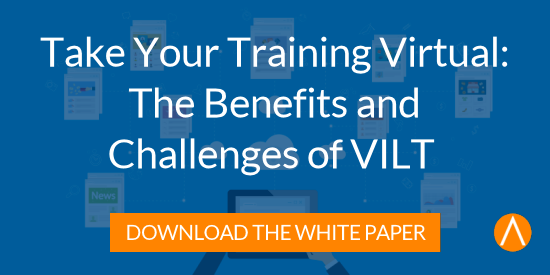Posted by Caveo Learning ● August 19, 2020
What's Next for Virtual Reality and Learning?

Dave Beck is a founder and Managing Partner at Foundry 45, an immersive technology company that develops enterprise-level virtual reality (VR) training experiences. His company has built over 250 experiences for notable clients such as AT&T, Coca-Cola, Delta, and UPS. With an evident passion for what he does, Dave has become an industry thought leader. He is a frequent speaker on topics related to technology and the future of learning.
Prior to starting Foundry 45, Dave held leadership positions in both training (Training Manager at PepsiCo) and technology (COO at EquipCodes, a mobile and augmented reality company). Dave also serves as a board member at Georgia Tech, the Metro Atlanta Chamber of Commerce, and the MAK Historic District. He earned his BS from Wake Forest University and his MBA from Georgia Tech.
What do you see as upcoming trends in learning?
I see training as being more important now than ever. People are working more remotely, it’s easier than ever to measure and track performance, and it’s more immersive. With shifts in work groups, reskilling and upskilling are huge as well. Immersive technology like VR training is a very powerful way to train/reskill/upskill. On the one hand, it’s great for bringing on new employees and getting them up to speed quickly and safely. On the other hand, it’s a powerful tool to teach existing employees new skills (or to reinforce existing skills).
What is on the horizon for VR?
There will be pretty standard hardware technology improvements. They will be better, smaller, cheaper, and more capable. Overall, the most important trend is that immersive VR is going to be moving from PC-based platforms to more mobile devices that are lower cost and easier to deploy.
And there will be changes in VR training content. It will be more integrated with existing IT infrastructures, most commonly with Learning Management Systems (LMS). Companies don’t want VR training to sit off to the side in a separate bucket. That’s fine for a proof of concept, but for anything beyond that it needs to live within the existing systems.
How do organizations make a case for VR? What is the business reason/benefit?
There are several different ways you can do that. A common way includes reducing training costs by drastically lowering the amount of time employees spend training, while still improving their learning retention. Additionally, cost savings are realized by reducing employee travel and alleviating a good deal of equipment downtime.
And, importantly, VR training can make learning much safer and more accessible. For example, Delta Air Lines has always had a challenge training their ramp workers. These are the folks tasked with turning the plane around safely and quickly when a flight arrives at the gate. They can’t train on an active jetway, they can’t take a plane out of service, and they can’t even get employees badged by the FAA for weeks and weeks. Their solution is VR training. They’ve now put thousands of employees through it and have had great results. Employee satisfaction is way up, costs on travel to training locations is way lower, and overall it got them excited to do a lot more VR training.
How do you recommend learning leaders get started in VR?
Start by finding an experienced partner. It’s a collaborative process, and you will want to work with people who have been there and done that. If you have an interest in doing anything beyond a one-off project, ask questions about your partner’s experience in bringing enterprise-scale VR training initiatives to life. For example, find out if they have experience integrating with corporate IT systems. If they’ve connected with an LMS, find out which one, etc. And finally, start with the goal in mind. Be sure you know what KPIs will be used for your experiences so that you can design something that can be measured when it’s in use. That’s the best way to demonstrate ROI and validate your work.
How did you get into this business?
Before starting work in the immersive technology space in 2011, I had experience working in training for a Fortune 500 business. Training is a natural fit for VR because VR is an experiential medium. In it you get to actually do the thing you’re learning about. We started off taking a wider approach. We did everything from soft skills, 360 degree video training experiences to more hard skills, immersive VR training. Over the past several years, we really homed in on the intersection of hard skills, think procedural training for the most immersive VR platforms like Oculus Quest and HTC VIVE. We believe that’s where businesses receive the most value, and it’s also where a team of engineers and coders like Foundry 45 can really shine in taking complex tasks and realizing them in virtual reality environments.
Topics: Learning Trends, Learning Technologies, Interviews with Learning Leaders

